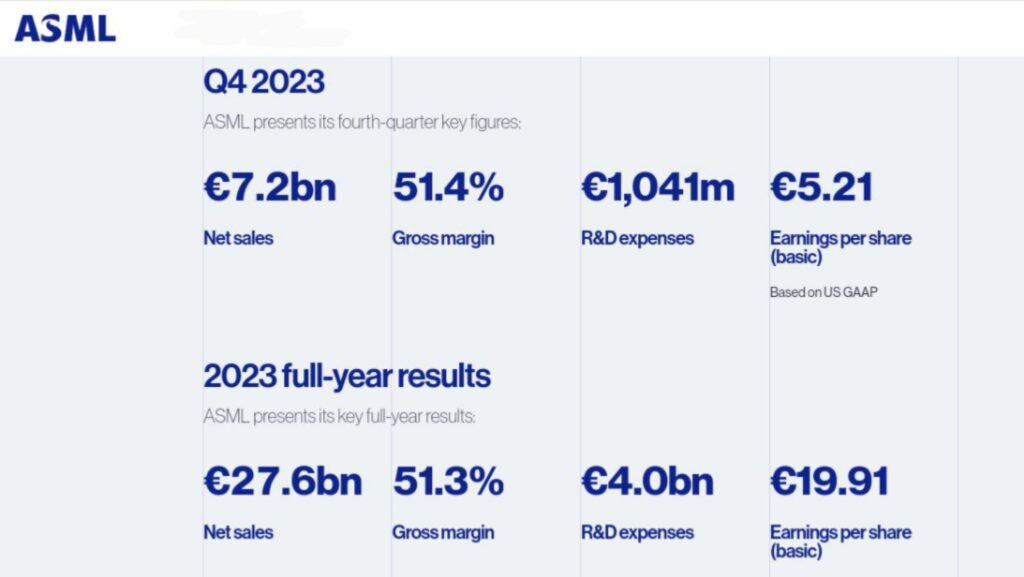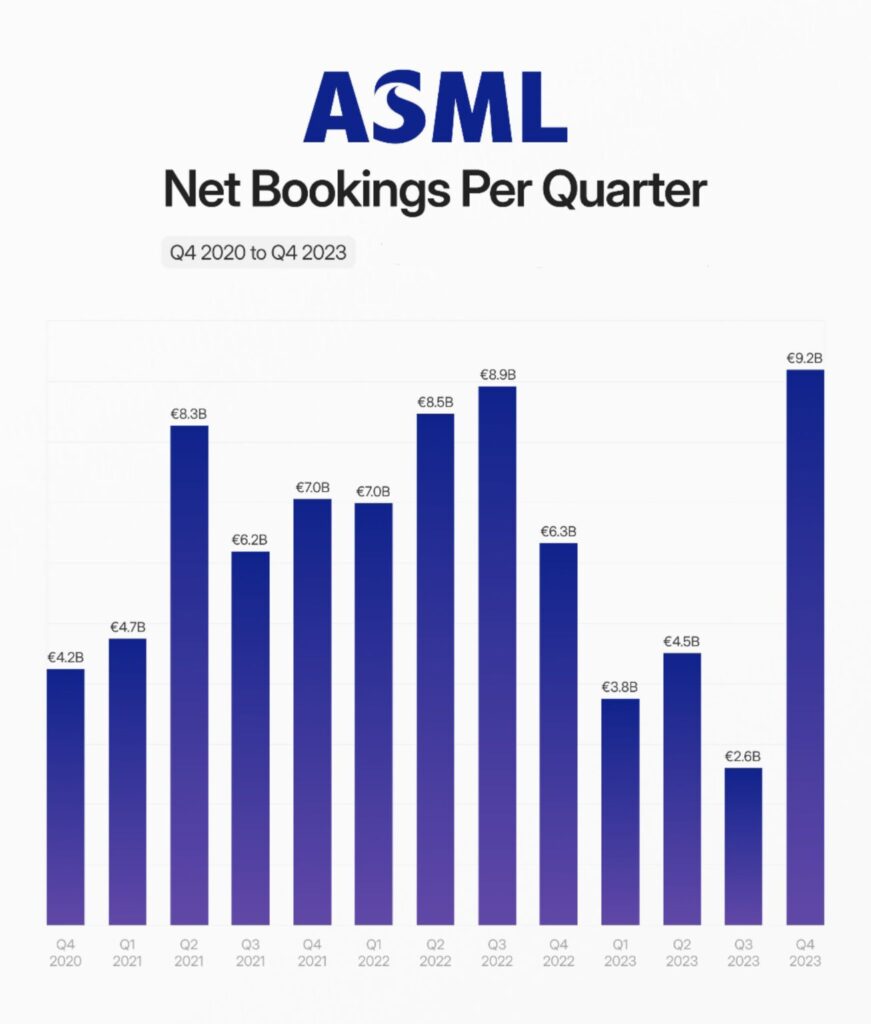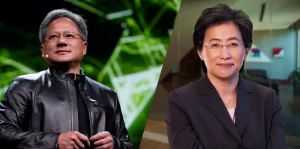Introduction:
In the dynamic landscape of the semiconductor industry, ASML, the world’s leading supplier of photolithography equipment, has recently released its Q4 2023 financial revenue & sales, painting a picture of resilience and growth.
ASML reports €27.6 billion net sales and €7.8 billion net income in 2023, 2024 expected to be a transition year with sales similar to 2023.
With net bookings reaching €9.2 billion, a remarkable 45% increase year-on-year, and an impressive 253% quarter-on-quarter surge, ASML’s performance is a strong indicator of the semiconductor sector’s rebound.
In this blog post, we’ll delve into the key highlights of ASML’s Q4 2023 results and explore what this means for the broader semiconductor industry.
Follow us on Linkedin for everything around Semiconductors & AI
Q4 2023 Financial Overview:

Image Credits: ASML
1. ASML Net Sales: +13% (y/y)
ASML reported a 13% year-on-year increase in net sales for Q4 2023, reflecting sustained demand for its cutting-edge semiconductor manufacturing equipment. This uptick in net sales suggests that semiconductor companies are investing heavily in advanced technologies to meet the growing demand for innovative electronic devices.
Read More: ASML Makes History: First High-NA 300M$ EUV Litho Scanner Shipped to Intel; Resolution upto 8 nm
2. Systems Sold: +17% (y/y)
The number of systems sold by ASML experienced a notable 17% year-on-year growth in Q4 2023. This surge in demand for ASML’s systems implies a robust appetite for semiconductor manufacturing equipment, reinforcing the notion that the semiconductor industry is on a path to recovery.
3. EBIT (Earnings Before Interest and Taxes): +13% (y/y)
ASML’s Q4 2023 EBIT saw a commendable 13% year-on-year increase, indicating the company’s ability to maintain healthy profitability even as it navigates a complex global economic environment. This growth in earnings underscores the strong market position of ASML and the semiconductor industry’s overall health.

Image Credits: Quartr
4. Margin: 33% (unchanged)
ASML’s margin held steady at 33%, demonstrating the company’s efficiency and stability. Despite the challenges posed by global economic uncertainties, ASML has managed to maintain its profit margin, showcasing resilience and effective cost management.
5. EPS (Earnings Per Share): +13% (y/y)
Shareholders will be pleased to note a 13% increase in earnings per share, indicating that ASML’s financial performance is not only strong at the operational level but also translating into tangible returns for investors.
Read More: How Much Do You Know about ASML?
6. Net Bookings: +45% (y/y)
Perhaps the most significant highlight is the 45% year-on-year increase in net bookings, amounting to €9.2 billion. This surge in demand for ASML’s products underscores the industry’s confidence in the future trajectory of semiconductor markets.
ASML Breakdown of Net Bookings/Sales:
1. Memory Segment: 47%
The 47% contribution from the memory segment in net bookings underscores the ongoing demand for memory-intensive applications. This includes a wide array of products such as storage devices, smartphones, and other consumer electronics where memory plays a critical role. As the need for data storage and processing continues to escalate, semiconductor companies are investing heavily in memory technologies to meet these demands.
2. Logic Segment: 53%
The logic segment, representing 53% of net bookings, encompasses the production of microprocessors, integrated circuits, and other complex semiconductor components vital for computing and digital processing. The significant share of logic segment bookings indicates a strong emphasis on enhancing computational capabilities, reflecting the industry’s commitment to advancing technologies for applications like artificial intelligence, machine learning, and high-performance computing.
Read More: Chipmaking Monopoly: How ASML Became Undisputed Leader in Lithography
3. EUV (Extreme Ultraviolet) Technology: 61%
The remarkable 61% contribution from EUV technology in net bookings signals a pivotal shift towards advanced lithography techniques. EUV technology enables the production of smaller and more densely packed semiconductor components, leading to increased processing power and efficiency. This high adoption rate highlights the industry’s pursuit of cutting-edge manufacturing processe. This is essential for meeting the demands of modern electronic devices.
ASML Regional Breakdown of System Sales:
1. China: 39%
China’s commanding position with 39% of system sales underscores its pivotal role in the global semiconductor market. The country’s growing demand for electronic devices, coupled with its strategic investments in technology, positions it as a major player in the semiconductor supply chain. The high system sales in China also reflect the nation’s emphasis on achieving self-sufficiency in semiconductor manufacturing.
2. Taiwan: 13%
Taiwan’s 13% share in system sales indicates its significance as a semiconductor manufacturing hub. The island nation is home to major semiconductor companies and plays a crucial role in the production of advanced electronic components. The contribution from Taiwan highlights the importance of its semiconductor ecosystem in the global context.
3. South Korea: 25%
South Korea’s substantial 25% share in system sales underscores its strong presence in the semiconductor industry. The country is home to major memory chip manufacturers and is a key player in technology innovation. The high system sales in South Korea reflect the nation’s commitment to advancing semiconductor technologies and meeting global demand.
4. USA: 11%
The USA’s 11% share in system sales reflects its continued significance in the semiconductor industry. As a hub for technological innovation and home to major semiconductor companies, the United States plays a crucial role in shaping the industry’s landscape. The contribution from the USA signifies the nation’s ongoing investment in semiconductor research, development, and manufacturing.
5. EMEA (Europe, Middle East, and Africa): 8%
The 8% share in system sales from the EMEA region highlights the diverse geographic spread of semiconductor manufacturing. While not as dominant as some other regions, EMEA’s contribution underscores the global nature of the semiconductor industry and its impact on various economies within the region.
6. Japan: 3%
Japan’s 3% share in system sales reflects its continued involvement in semiconductor manufacturing. Japan has a long history of contributing to the global electronics industry. Its presence in system sales reaffirms its role in semiconductor production and technological innovation.
7. Rest of Asia: 3%
The 3% share in system sales from the rest of Asia further emphasizes the widespread influence of semiconductor manufacturing across the continent. Various countries in Asia contribute to the global semiconductor supply chain, reflecting the region’s importance in meeting the growing demands of the tech industry.
Read More: ASML to Install 600 DUV Machines by 2025 in China
ASML: A Flat 2024 Outlook
ASML, a critical player in the semiconductor industry known for producing essential machinery for advanced chip manufacturing, has reported an impressive 30% surge in full-year revenue. However, the company has issued a cautious outlook for 2024, signaling a potential slowdown in sales compared to the previous year. Despite surpassing market expectations in terms of both revenue and profit, ASML anticipates a flat performance in sales for 2024.
The Dutch company, integral to the production of the world’s most advanced chips, finds itself entangled in the broader technological rivalry between the United States and China. Notably, ASML faced a setback recently when the Dutch government decided to partially revoke its license for shipping NXT:2050i and NXT:2100i lithography systems to China in 2023.
Read More: 10-15% Sales Hit For ASML in China Amidst US Ban
Conclusion:
ASML stellar Q4 2023 revenue performance serves as a beacon of hope for the semiconductor industry. The robust net bookings, increased system sales, and strong financial metrics collectively suggest a rebound in the sector. This is driven by growing demand for advanced electronic devices.




